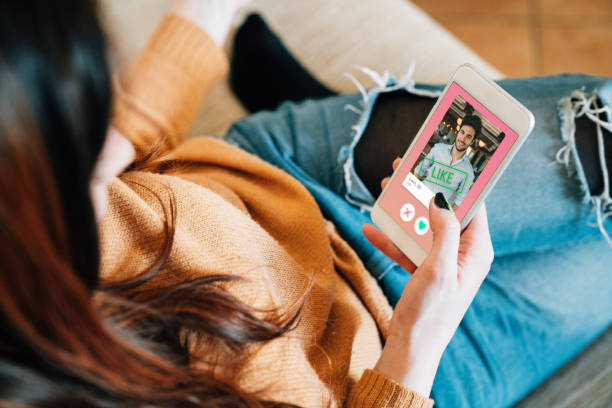Young Adults and Online Dating: Proceed with Caution
September 1, 2021
Conglomerate match-making companies dominate the field yet fail to offer genuine connections and personal safety tips.
The online dating industry reached 3.08 billion dollars of revenue in 2020, nearly doubling the amount made in 2015 (1.69 billion dollars). There is no doubt that the online dating industry is growing at an amazingly fast rate. But how does this affect young adults?
A Pew Research Center survey found those aged 20 to 34 used dating services more than other age groups (22%) from 2013-2015. Comparatively, those aged 18-24 had the highest increase from 10% to 27%, the research found.
The industry is aware of the shift in the age of its users too. In a 2012 advertisement, Match had people talk about the last time they dated. This advertisement focused on a 47-year-old divorced woman, a man who said he was in a “different stage of life,” and another who claimed that when he last dated there was no Internet.
In contrast to the previous commercial, Match’s 2017 advertisement showed young adults recording themselves on smartphones and talking about how they hope to find somebody through the app.
Unfortunately, when it comes to finding the long-lasting love of their lives, this demographic needs to proceed with caution.
Prospective members of the college online dating scene should be aware that if they’re looking for love, they are in the minority. A survey by ADOBO that surveyed 3,500 college students who used online dating apps found that only 11.5% of their applicants answered that love was their primary reason for using these apps.
The 18-24-year-old age group was also the most likely to report having negative interactions with people through online dating services according to a Pew Research survey. Within this age group, women in particular reported instances of harassment more than any other group.
In the worst of cases, online dating has led to murder. Sydney Loofe, a 24-year-old woman from Nebraska, met a woman on Tinder. After their first date went well, she decided to go on a second date with the woman. Tragically, after Loofe was lured to the woman’s apartment, the woman and her boyfriend killed her.
A paper published by the Building Healthy Academic Communities Journal found that 83.7% of college students will attempt to meet with someone they met online in person. They also discovered that 72% of sexual assaults happen in either the victim’s or suspect’s residence, and 52% of victims had sexual interactions with the person who assaulted them before meeting in person.
These statistics paint a terrifying picture when it comes to college students and their use of online dating services. The willingness to spread information with strangers has undoubtedly contributed to people getting harmed.
Many companies such as Bumble and Match Group, the parent company of Tinder, Match, Hinge, and many more have posted safety tips and conduct guidelines to their websites in an attempt to add security to their platforms. However, while these guidelines are clearly listed within their web pages, they are usually located on the bottom of the pages in small text. This can make it harder for users to find the material to educate themselves, possibly ending in someone getting assaulted or harassed.
Beyond these guidelines, companies also offer more specific safety measures such as Tinder who offer features such as photo verification, video chatting, and reporting resources. Tinder also announced a feature where users can verify their online identity using their ID, on Aug. 16. This feature would be optional in places such as the United States where there are no laws that make social media users verify their identity.
While many of the safety options provided by dating services are optional features, a new start-up located in San Francisco is hoping to change the online dating game. In an interview with The Pioneer, Allie Constantino, the marketing manager of SwoonMe discussed the app and how it will be a safe experience for its users.
SwoonMe allows users to create an avatar using a picture of themselves and utilizes audio clips of the person’s voice answering questions in place of a biography. These voices are the primary factor people have when deciding who to match up with and pictures of the person’s face aren’t revealed until a match is made. Constantino hopes that this concept will focus on the important part of dating: personality.
“SwoonMe is like, hit play, listen to it, immerse yourself in the dating. You have that upfront investment, unlike other dating apps where you just upload a photo or have an album on your phone of your best photos. [It] focuses on the important stuff.”
When asked about the problem of people over-sharing information on other dating sites, Constantino said: “It’s very easy to connect your social media to other dating apps, but we’re currently developing some ice breakers where you answer through audio a bunch of questions first before you see the other person’s social profiles, what they look like, or all the info,” Constantino explained.
On top of the ice breaker feature, SwoonMe, which is available in in-app marketplaces like the IOS Store and Google Play, hopes to introduce additional safety features. Constantino said, “We’re adding extra steps as well to verify a person’s voice and their photo behind the avatar. We have a team as well, we are creating to be community moderators”. “Fake info won’t be allowed and phone numbers can only be used once. To verify the photo, the user has to take a 180-degree video that matches the photo for their avatar.”
SwoonMe has customers in both domestic and international media and a steady following without any paid advertising. The company differs from conglomerates like Tinder in the sense SwoonMe prides itself on true connection without facetious appearances. The company takes security and user safety extremely seriously through implementing additional verification steps.
When it comes down to joining these services, people, especially those aged 18-24, need to be aware of what they’re getting into, read the statistics on harassment and abuse, and research how these companies are willing to protect them.







